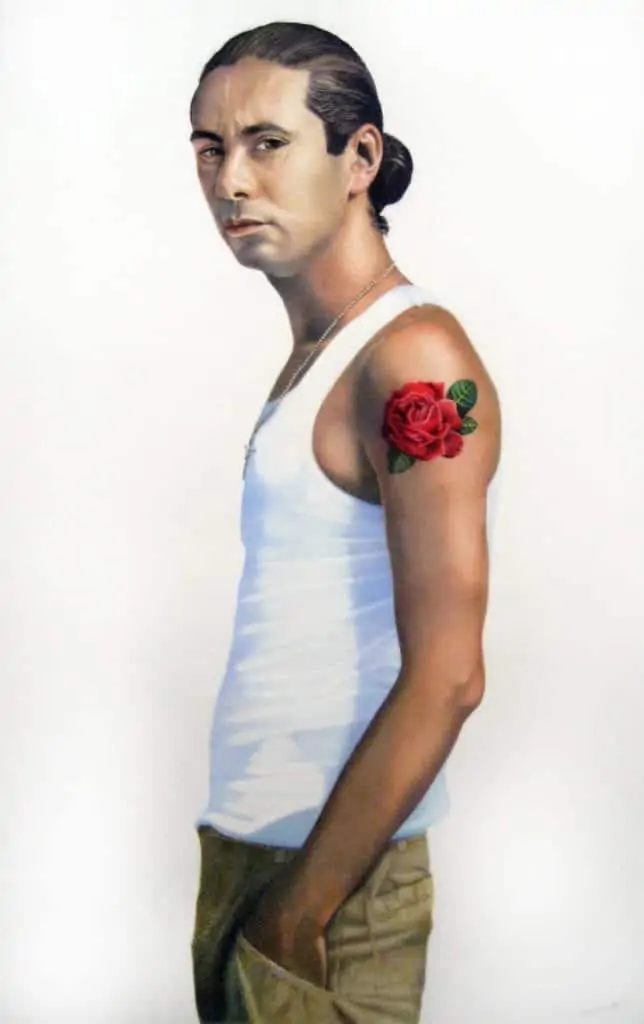

One after another, visitors to The Art League Gallery this weekend stopped in front of the Best in Show award winner, pictured above, and said the same thing: “Is that really colored pencil?!” You might remember having a similar reaction in December when the same artist, Suzanne Vigil, had her exhibit of time- and pencil-consuming photorealistic portraits, “Up Close & Too Personal.”
For a quick look at Suzanne working in her studio, you can watch our December video here. Suzanne told us more about the art of portraiture, creating characters, and just how long these large portraits take to draw (hint: it’s a very long time). Read all about it in our Q&A, below:
What’s the story behind Home Grown?
I am beginning a series called “Labels.” I’ve always been intrigued when listening to authors relate how they develop a character and thought I’d apply this method to my drawings.
I began doing this young man, working primarily on the front of the face. My first thought was he might be a matador and wear a “traje de luces” (suit of lights). As I worked the eyes and furrowed brow I began to see a sadness. His story began to slowly emerge along with his facial characteristics. As I’m drawing, I’m thinking about his life experiences.
Here is a young man who is about to leave 12 years in the East L.A. schools. The sadness in his eyes shows he understands the most he can aspire to be is a gardener. But along with his sorrow is a fierce determination that he learned from his parents. If he will be a gardener, he will be the best. In an ultimate expression of pride he has tattooed a large red rose on his shoulder as a visual statement to the people whose grass he cuts and flowers he cares for.
He has donned his “homey” uniform of tank top, chinos and the crucifix he got from his mother and father for his first communion.
His name is not Jose.
His name is not Juan.
His name is Felicidades (which means “congratulations”).
What makes a successful portrait? What was your goal for Home Grown?
I think a great portrait does more than reflect an image. It needs to tell a story. The concept of my new series, “Labels,” is to let the viewer make a snap judgement. We all “tag” people based on appearance. One of life’s best-learned lessons is to know how off-base that really can be. Felicidades is an American. He may be a gardener and wear homeboy clothes, but deep inside he has pride and determination. Perhaps I need to consider attaching a narrative with each drawing.

You work with both pencils and paint — what appeals to you about each? Do you find yourself switching back and forth often?
I do like to paint because it’s such a relief from the intensity of pencil. Last month I gave a two-day workshop for members of the Colored Pencil Society of America (CPSA). The first tool I recommended was an industrial magnifying light. They weren’t so convinced until about an hour into the demo when they all took note of the brand name. Paint, on the other hand, lets you get some immediate results, especially alla prima. These larger portraits will take at least 100 hours so when my hand gets cramped I love to switch over to a big fat brush.
For people who haven’t seen your video in December, can you tell us a little about why and how you use the acetate backing?
I discovered acetate when I was a graphic artist at the Drug Enforcement Administration (35 years). When we switched from “on-the-board” production to computers, all of the low-tech supplies were removed. I rescued a substantial stack of acetate and begin experimenting with different media. The surface was perfect for pencil. I found I could achieve the reflections of a polished steel ball as well as a coarsely woven wool fabric. Even more exploration of the media revealed that I could work both sides of this frosted acetate. By adding color to the back, I could intensify color on the front, or, for instance, if I were drawing an apple, I might add tones of green on the reverse side. There are no rules but endless experimentation.
What are you working on now?
My next piece is a gregarious young man who is emerging as an athlete of sorts. Not sure what his entire story is because I’m only about a third into the portrait.
Sign up for our weekly blog newsletter, subscribe to our RSS feed, or like us on Facebook for the latest Art League news. Visit our homepage for more information about our classes, exhibits, and events in Old Town Alexandria, Virginia.
You can support The Art League every time you shop through AmazonSmile!
Simply set The Art League as your chosen charity, and every time you shop at smile.amazon.com, a portion of your purchase will be donated to support our mission to share the experience of visual arts with the community.